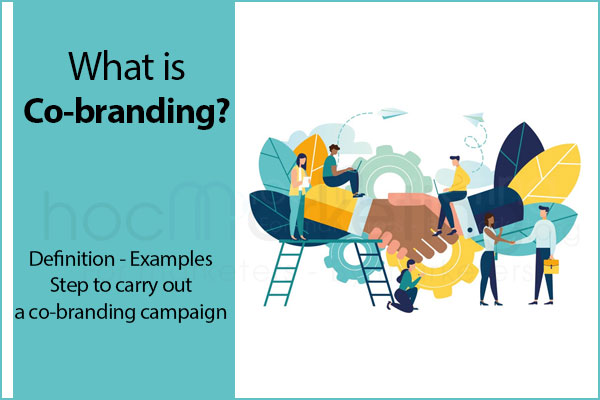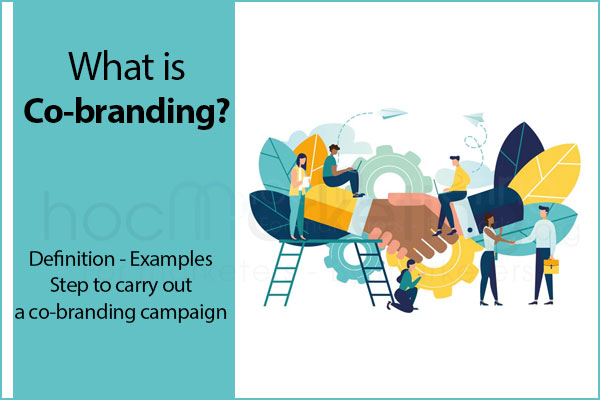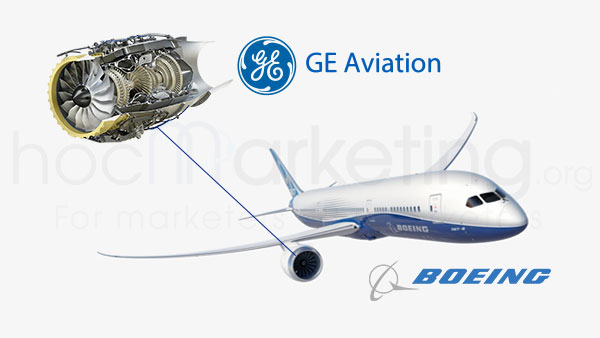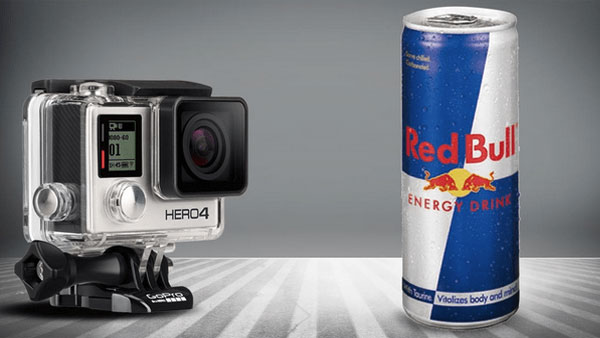
What is co-branding? Steps to carry out a co-branding campaign

Co-branding is a new strategy that can be used to increase your online presence and generate more leads. This blog post will explore how to use this technique and what steps need to be taken before embarking on this journey with another organization.
Co-branding is a new strategy that can be used to increase your online presence and generate more leads. For example, if you are an accounting firm, you may want to co-brand with an insurance company. This way, when someone searches for "accountant" in Google or Bing they will see the two companies listed together on the first page of search results.
This blog post will explore how to use this technique and what steps need to be taken before embarking on this journey with another organization.
What is co-branding?
Co-branding is when two companies partner up to sell a product together, while both retaining their individual brand identities. This technique has been around for quite some time, but it is now being used more than ever since companies can engage directly with their customers online.
Major types of co-branding
1. Ingredient Co-branding
Ingredient Co-branding is a strategy in which the products of one enterprise are components (components, parts, materials) of products manufactured by another enterprise.
2. Composite Co-branding
Composite Co-branding is a strategy in which businesses cooperate to participate in a process of implementation, production, and construction to create a new product, program, event, or media story.
Examples of well-known co-branding campaigns
Dell & Intel (Ingredient co-branding)
Dell & Intel can be seen as a prime example of a ingredient co-branding campaign. Both are in the technology sector, with Dell being the supplier of computer equipment products and Intel being the leading brand in the field of manufacturing CPU microprocessors. Dell & Intel embarked on the Co-branding process very early, before both brands became famous around the world. The first product of this partnership was the desktop computer the "Turbo PC" released in 1985 (At that time Dell was known as PC's Limited). The co-branding process has helped both businesses reap the benefits of sharing knowledge, experience and even risks. In addition, Dell's reputation is enhanced by launching products with stable performance that increase over time, while Intel can benefit by reducing the entry probability of competitors. Dell gets a hefty discount from Intel, while Intel enjoys a stable, long-term customer base. In addition, Intel supports Dell advertising and offers other incentives.
Boeing & GE (Ingredient co-branding)
Boeing is a famous manufacturer of aircraft and spacecraft while GE is a brand of jet engines with a large scale. Besides, jet engines are one of the important strategic factors for Boeing, while Boeing can help GE enhance its brand value, so the two have co-branded together. together. The cooperation has brought both businesses many valuable values. With Boeing, by emphasizing the use of GE engines, Boeing always builds trust in aircraft distribution partners. With GE, the company has a strong and stable source of output products, along with a growing reputation in the corporate market. This partnership clearly demonstrates an existing GE advertisement that states that the company is now exclusively supplying the GE90-115B engine, "the world's newest and most powerful jet engine", for the machine. Boeing's long-range 777.
GroPro & Red Bull (Composite co-branding)
GoPro is a well-known brand for portable cameras and camcorders, while Red Bull is a leader in the energy drink market. It seems that the two brands above soon realized what they have in common, that is, both represent a lifestyle full of energy, action, adventure, and adventure. This led the two to soon join hands in a Co-branding campaign.
The campaign that the two sides cooperate with is carried out mainly through events and competitions on extreme sports. In this campaign, GoPro - with the advantage of technology - is responsible for equipping athletes with specialized cameras to be able to record clearly and realistically the process of activities and stunts. that they perform. Meanwhile, Red Bull leverages its experience and reputation to operate and sponsor these events.
The campaign seems to have succeeded beyond the expectations of both sides. The event programs co-operated by the two sides were successful, highly appreciated by experts and attracted countless audiences around the world. Among the events held, perhaps the most prominent was the challenge of Felix Baumgartner to jump from space to the surface of the Earth with a GoPro and a Red Bull branded outfit. That success has helped both brands achieve a common goal: affirm the message the brand wants to convey.
Over time, GoPro cameras have always been the first choice for adventurers, extreme sports organizations or action studios. Meanwhile, Red Bull continues to maintain its leading position in the energy drink market.
BMW & Louis Vuitton (Composite co-branding)
BMW (car maker) and Louis Vuitton (manufacturer of suitcases & bags) are two brands that are not in the same field, market share but possess many things in common. Both brands target the high-end segment, affirming the value of luxury and nobility. Realizing this similarity, both businesses decided to shake hands in a Co-branding campaign.
In this Co-branding campaign, BMW developed and launched a sports car called the BMW i8, while Louis Vuitton designed an exclusive set of suitcases and bags (consisting of four) that perfectly fit the area.
This set of Co-branding products not only attracts the attention of the elite, who like to spend on beauty and luxury, but also attracts more customers who regularly consider spending. If spending $20,000 on a branded bag was considered too expensive, customers can now feel more comfortable buying them with a high-end car for a total of $180,000, people with You may not feel comfortable buying $20,000 designer bags. This campaign helped Louis Vuitton increase sales, while BMW also benefited from increasing market share by selling new models. Both still affirm the brand value: representing high-class and luxury.
The benefits of co-branding
1. Co-branding helps businesses increase their competitive advantage
Each brand has its own strengths. That strength can be prestige, financial resources, technology, human resources, intelligence... Therefore, the combination of 2 or more brands will create superior competitive strength, thereby helping enterprises have a great advantage in the competition for market share with other competitors.
2. Co-branding helps improve brand awareness
Every business has a limited budget for communication and promotion. Therefore, Co-branding can help businesses overcome this limitation when participating parties can take advantage of the partner's budget and communication channels, thereby expanding the scale of promotion and brand coverage doubled up.
3. Co-branding helps increase market share & sales efficiency
Thanks to the fact that businesses work together to sell certain items, Co-branding is an effective strategy for many businesses looking for new customers, profits, market share, without spending too much cost.
The risks of co-branding
Although bringing many benefits to businesses, Co-branding still has certain limitations.
1. Disagreement about the vision and goals of each brand can hinder the cooperation process.
Each brand has its own vision, goals, long-term or short-term. In some cases, this difference can hinder cooperation. For example: Brand A is in the process of building trust and reputation, wishing to provide consumers with products with guaranteed quality. However, brand B is aiming to expand market share, with a strategy of distributing low-cost products to the market. It is the contrast between the two factors of quality - cheap that will make the cooperation process difficult.
2. Some businesses promote their own interests instead of the common interests in a Co-branding campaign.
Not every business participating in a Co-branding campaign is dedicated to the mutual benefit of the partnership. Some businesses only promote their own interests, or even have their own plans that their partners do not know. For example, a business with the goal of pursuing profits can take advantage of the reputation and reputation of a partner's brand to sell poor quality products to the market.
3. The failure of one brand can negatively affect the value of the other.
In a co-branding campaign, the collaborating brands form an invisible bond with each other. The bond is so strong that the failure of one brand can negatively affect the other.
What is required for successful co-branding?
Before embarking on this endeavor, it is important to examine what the co-partners bring to the table. These days, people are used to receiving promotional offers in their email inbox from companies they have never heard of before. If the company want its customers to trust a brand, it is vital that both companies establish themselves in the marketplace before launching a co-branded product.
It also helps if both brands have a similar target market or sell complementary products. For example, if they are selling children's toys, both companies should be targeting parents with young kids at home. If these two criteria aren't met before launching the co-branded product, there is a good chance that the new venture will fail because the targeted consumer won't be interested in purchasing both products.
Steps to carry out co-branding
Now that we've discussed some of the benefits associated with co-branding and what is required to make a successful venture, let's take a look at how an actual marketing campaign can be put together.
In order to successfully implement online co-branding, there needs to be coordination between both companies involved on all levels. For example, websites need to be created that appeal to the targeted consumer and both companies have to send traffic in one direction.
The following steps can be taken to create a successful co-branded campaign:
Step 1: Clearly define the goals & criteria of the Co-branding campaign
In the first step, businesses need to determine what is the goal that they want to direct in the Co-branding campaign? Can businesses achieve that goal without co-branding? What are the strengths and weaknesses of the business? How do businesses need to find partners and brands to achieve that goal?
Clarifying the above criteria will help businesses have an initial basis for finding partners, negotiating or building cooperative marketing programs.
Step 2: Investigate and screen partners
Before implementing any online advertising campaigns, it is important to get approval from both organizations involved in order to avoid costing either one company money. For example, if the accounting firm suggests that both businesses purchase Google Adwords, the second company should have the ability to veto this idea.
Step 3: Negotiate and agree on cooperation goals
Before deciding to cooperate, businesses need to clearly understand the partners they will work with. Not only about the history of the brand's development, businesses also have to learn carefully about the development goals, working style, corporate culture, financial health... of partners.
In addition to avoiding the risks of failure and unfortunate incidents in the cooperation process, researching & researching about partners also helps businesses to filter out partners who share the same goals, culture or style. working.
Step 4: Build a Co-branding Marketing plan
After having an initial agreement on cooperation goals, both sides began the process of developing a Co-branding Marketing plan. In general, this plan is essentially the same as the internal marketing plan of each business. What makes the difference is the context. If before, businesses built plans based on their own resources and goals, now, businesses have more resources of partners and cooperation goals. Therefore, both sides need to understand the competitive advantages, as well as the limitations of the opponent to make the right decisions and the appropriate assignments.
Typically, a Co-branding Marketing plan includes a plan for product development, distribution, promotion, and communication.
Once the groundwork is complete, both companies can then start to advertise their product or service together online. Many websites have pop-up forms that seek out information from consumers when they are interested in a particular subject. In these cases, a targeted ad campaign can be launched by both partners that will send traffic to the right place.
In the same way that both companies need to be on board when creating ads or promotional material, it is important for both organizations to agree on where their online content will be promoted. This includes social media sites like Facebook and Twitter, as well as popular review sites like Yelp and TripAdvisor. The more the two companies work together on every level, the better chance they have of making a sale.
Step 5: Implement the Co-branding campaign
After having in mind the Co-branding plan, the "brand alliance" embarked on the implementation of the planned campaign. At this step, enterprises need to ensure that the implementation process is based on close, seamless and smooth coordination. Both parties need to grasp the work progress, problems and difficulties arising in the implementation process so that their partners can have appropriate and timely support plans.
Step 6: Monitor, measure and calibrate
During the implementation of the campaign, it is extremely important to monitor, measure and report the effectiveness of the campaign. This work will be done according to the assignment of the enterprise and the partner. After a certain period of time (1 day, 1 week or 1 month), based on the report results, both businesses will sit down to discuss and make appropriate adjustment decisions to improve efficiency. results of the Co-branding campaign.
Summary
Co-branding (co-branding) is one of the marketing strategies to help businesses achieve marketing goals or promote outstanding brand development without spending too much. However, besides the great benefits it brings, Co-branding still has many limitations that businesses need to be aware of. Sometimes, failure in co-branding can lead to the downfall of a great brand.























